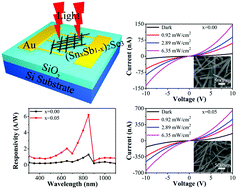A high performance broadband photodetector based on (SnxSb1−x)2Se3 nanorods with enhanced electrical conductivity†
Abstract
Sb2Se3 is a highly interesting narrow band gap semiconductor with promising applications in new-generation electronic and photoelectronic devices. However, it has intrinsically low electrical conductivity, which limits its broader scope of applications. To overcome this challenge, Sn-doped Sb2Se3 ((SnxSb1−x)2Se3) nanorods with enhanced electrical conductivity are firstly synthesized via a facile hot-injection method. With increasing the doping concentration of Sn4+, the (SnxSb1−x)2Se3 nanorods exhibit several orders of magnitude improvement in electrical conductivity, which originates from the increase of carrier concentration. The photodetector based on the (SnxSb1−x)2Se3 nanorod film shows a higher responsivity (6.21 A W−1) and external quantum efficiency (906%), a lower noise equivalent power (3.14 × 10−13 W Hz−1/2), and a fast response time (0.04 s), surpassing the performance of the Sb2Se3 nanorod film photodetector. In addition, the (SnxSb1−x)2Se3 nanorod film photodetector also displays a broadband spectral response ranging from UV to IR. Those excellent performances unambiguously demonstrate that the (SnxSb1−x)2Se3 nanorods are promising for utilization as highly efficient broadband photodetectors.



 Please wait while we load your content...
Please wait while we load your content...